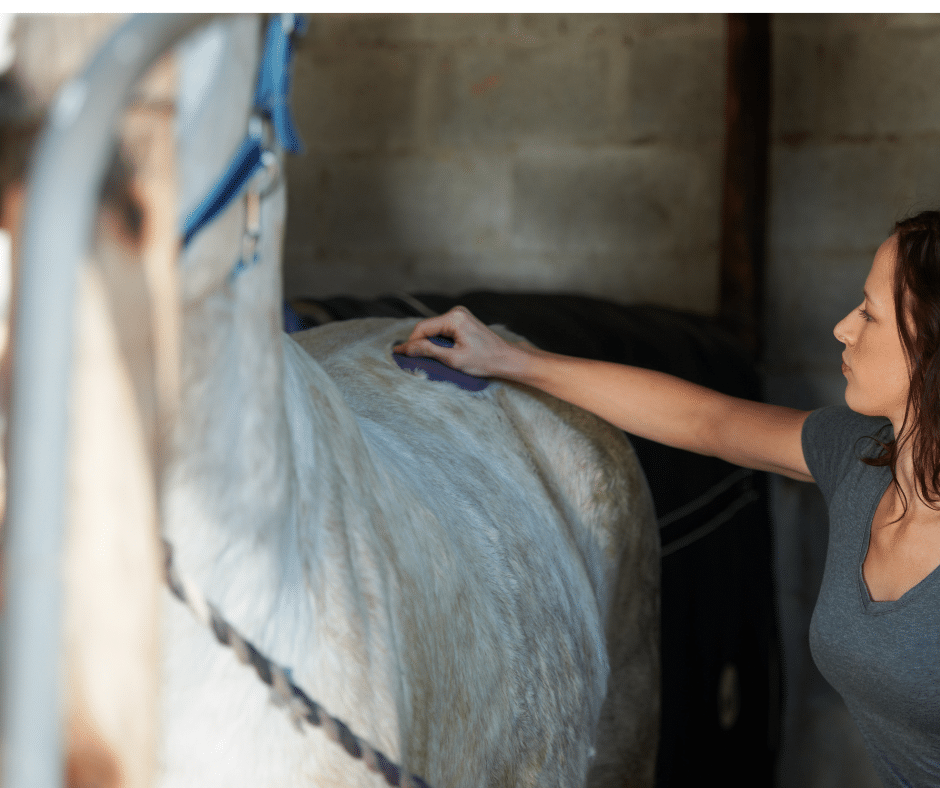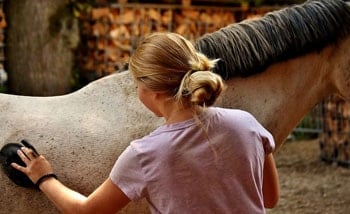Spring Horse Shedding Guide: Tips & Tricks for Equestrians
It’s Springtime! For most people, this means that the birds are chirping and the leaves are budding. For horse owners, this signals something unique: horse shedding - and yes, horse hair is probably EVERYWHERE on your property.
Dealing with the natural cycle of horse shedding and hair growth is an integral part of caring for your equine companions. However, as an owner, there are strategies to hasten this process and ensure your animals’ comfort.
In this article, we’ll dive into the most effective ways to care for your horse during the shedding season. Plus, discover some handy tips to make the shedding process even more efficient!
Understanding Spring Horse Shedding: Causes & Cycles
The longer hair growth we see in horses corresponds to colder temperatures - a common understanding. Yet, it’s the increasing daylight hours that actually prompt this change.
According to studies, such as those from Michigan State University, the decrease in daylight during fall leads to the growth of a thicker winter coat over the summer coat. Conversely, when days grow longer in spring, the increase in daylight triggers the shedding process.
This cycle is controlled by the horse's pituitary gland, which reacts to the changes in daylight hours and releases hormones that cause the coat to transition.
Navigating Horse Shedding and Hair Regrowth: Insights from Equine Experts
During spring, the increased daylight hours signal your horse to naturally shed their winter coat. This seasonal change, essential for their comfort, can be impacted by fluctuating temperatures.
Dealing with a Sweaty Horse Post-Ride
After a vigorous spring ride, managing a sweaty horse with a partially shed winter coat can be challenging. To gain expert insights on this, we consulted with Dr. Lauren Powell and Dr. Bonny Henderson from Henderson Equine Clinic, renowned for their expertise in equine care and grooming.
How a Horse’s Coat Insulates and Protects
Horses have a natural way of adapting to cold weather. The key is in their coat. Dr. Powell explains, "In colder months, horses grow a denser coat. This coat traps air between its layers, functioning like insulation in a house."
However, this natural insulation can be compromised. "When you blanket a horse, you flatten the hair, reducing its insulating ability," Dr. Henderson notes. Similarly, clipping a horse's coat for aesthetic or competitive reasons can diminish this natural protection, leaving them more susceptible to the cold. Especially in horses accustomed to warmer climates or those who have been blanketed previously, the winter coat might not be as thick, necessitating extra care in colder weather.
Effective Cooling Techniques for Shedding Horses in Cooler Climates
Understanding how a horse's coat functions is essential, especially during the shedding season when the weather is still chilly. Drs. Powell and Henderson emphasize the importance of properly managing a horse's body temperature to prevent hypothermia. Wetness from sweat or external moisture can compromise the coat's natural insulating ability, making it crucial to ensure that the horse is adequately dried and warmed after exercise.
Here are their combined recommendations for horse care during this critical period:
- Adequate Cooling Time: After exercise, it's vital to allow enough time for the horse to cool down. This period can vary from 10-20 minutes or more, depending on the horse. Ensure the horse has stopped sweating, the heart rate is normal, and the coat is dry.
- Utilize Cooling Tools Effectively: Employ tools like blowers and cooling blankets judiciously. These tools assist in maintaining a comfortable temperature while allowing the horse's sweat to evaporate.
- Natural Wicking Process: Horses naturally expel moisture from their coats, pushing it to the hair tips for evaporation. When using a cooler blanket, ensure it supports this natural process without causing the horse to overheat or sweat again.
- Manage Excessive Wetness: In cases where the horse is extremely wet, use absorbent materials like microfiber towels to remove excess moisture before applying the cooler. Regular checks are important to ensure the horse remains dry and comfortable.
- Routine Grooming: Regular grooming during shedding season not only helps with coat maintenance but also aids in observing and managing the horse's skin and coat health.
By following these steps and understanding the unique needs of shedding horses in cooler climates, you can help prevent discomfort and health risks like hypothermia. Keeping these considerations in mind is especially important when preparing a horse for transport in a trailer post-event.
Shedding Horse Management in Horse Trailers
If you do need to transport your horse while he’s in the final stages of drying off, make sure you provide him with a cooler blanket. Close all of the windows in your horse trailer, as well as vents, so he does not have to deal with excess air flow. And definitely do not transport in an open-sided stock trailer in chilly weather if your horse is still not cooled off and dry.
Dr. Henderson added, "Depending on the length of the trailer ride, the temperature outside, and how exposed the horse is to the wind in the trailer, it might be necessary to layer up on coolers. This can be done by using a combination of Irish knit coolers and Wool coolers, to keep the horse warm for the duration of the ride."
Four Effective Tricks to Accelerate Horse Shedding
Although horse shedding is completely natural (and necessary), it can be a pain both horses and horse owners. Here are a few tricks you can try to help speed up the process for your horse:
Trick #1: Light Management
Remember how we talked about light and its effect on hair growth? Well, you can actually add additional artificial light to your horse’s environment to trigger faster shedding. Just remember, you are still responsible for keeping your horse warm if his coat is thin and the temperatures are cold. The added light source can be turned on to produce a total of 16 hours of daylight for your animals. The intensity should be comparable to a 200-watt bulb for one 12x12 foot stall. More light than this won’t do your horse any good so don’t overdo it. It will take the horse about 60 days before you start to notice increased shedding.
Trick #2: Bathing Techniques
Bathing is a neat trick to speed up your horse’s shedding time (provided the weather is warm enough!) Use a conditioning shampoo to moisturize your horse’s new summer coat as it’s growing in.
Trick #3: Oil Treatments for Horse Coats
Hot oil treatments can work well to provide deep moisturizing for horses with dry coats. It will also help loosen the shedding hair. Be sure to dry your horse off very well with towels after their bath.
Trick #4: Clipping for Faster Shedding
Finally, a spring body clip can also speed up the process. But again, remember to provide your horse with extra blankets if you decide to rob him of his coat before the temperatures are warm enough.
Top Tools for Efficient Horse Shedding
Vigorous grooming can also help get your horse’s coat to shed faster. For this, think about using some serious elbow grease and tools designed specifically to shed out their coats.
Here are some great tools to stock in your tack box:
-
A curry comb is great for removing dirt, old hair and debris from your horse’s hair. Use it in a circular motion, but be careful using it around their face and legs where there is little muscle and sensitive areas.
-
Grooming mitts and gloves work well for the entire body including faces and legs because they are less stiff with flexible rubber knobs to pull off the hair.
-
Shedding blocks and shedding blades can also be used. Or, if it comes down to it, you can always use a nice brush with stiff bristles.
Read more here: Revealing the 6 Best Grooming Kits for Horses
Remember, horse shedding is a natural part of owning a horse. But if you use the right practices, you can help speed up this process and keep your horse comfortable and healthy.
We'd like to say a special thank you to Dr. Lauren Powell and Dr. Bonny Henderson of Henderson Equine Clinic in Avon, NY for their help with this article.
Frequently Asked Questions About Horse Shedding
Why is my horse shedding so much?
During spring, horses experience increased daylight hours and rising temperatures, prompting them to shed their winter coat. This process is controlled by the horse's pituitary gland, which responds to the longer daylight hours by releasing hormones that trigger the shedding of the thicker winter coat.
What month do horses start shedding?
Most horses begin their shedding process towards the end of February or the beginning of March. The exact timing can vary depending on the horse's breed and the local climate conditions.
Do horses shed year round?
While the most noticeable shedding occurs in spring, known as the horse shedding season, horses actually undergo a continuous cycle of hair shedding and regrowth throughout the year. This is why regular grooming is essential, as it supports coat health and allows for the monitoring of any skin conditions.
How can I stop my horse from shedding?
While you can't stop the natural process of shedding, you can help your horse shed its coat more quickly and comfortably. Regular brushing and combing, using tools like a shedding blade, can effectively remove loose hair. Additionally, this grooming process can stimulate the skin and promote a healthier coat.



